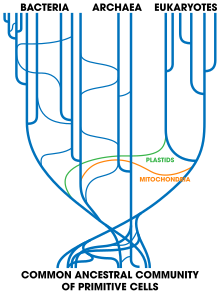Livets træ (biologi)

Charles Darwin foreslog, at fylogeni, arternes udviklingsmæssige slægtskab over tid, kunne udtrykkes ved en metafor, han kaldte Livets Træ (Tree of Life).[1] Den moderne videreudvikling af denne tanke kaldes det fylogenetiske træ.
Livets træ i nutiden
Træmodellen betragtes stadig som gyldig for eukaryotiske livsformer. I 2010 har forskning i de ældste grene af det eukaryotiske træ antydet et billede med enten fire[2][3] eller to overordnede grupper.[4] Der synes dog ikke at være enighed endnu, og Roger og Simpson konkluderede i en anmeldelse, at "med det nuværende tempo i udviklingen af vores forståelse af det eukaryotiske livstræ, bør vi fare frem med forsigtighed."[5]
Biologer anerkender nu, at prokaryoterne, bakterierne og arkerne har evnen til at overføre genetisk information mellem ubeslægtede organismer via vandret genoverførsel (Horizontal Gene Transfer (HGT)). Rekombination, fordobling og tab eller skabelse af gener er nogle af de processer, som gør, at arveanlæg kan overføres indenfor og mellem bakterie- og arkarter, hvad der skaber ændringer, som ikke skyldes ”lodret overførsel” (= arv).[6][7][8] Der er mere og mere viden om HGT blandt prokaryoterne både på encelle- og flercelleniveau, og det synspunkt vinder frem, som påstår, at Livets Træ giver et ufuldstændigt billede af livets udvikling. Det har været et nyttigt redskab i forståelsen af de grundlæggende processer bag udviklingen af prokaryoterne, men det kan ikke fuldstændigt forklare situationens kompleksitet.[7]
Se også
- Webprojektet livets træ
- Vandret genoverførsel
Noter
- ^ Welcome to the OneZoom tree of life explorer... An interactive map of the evolutionary links between all living things known to science. Discover your favourites, see which species are under threat, and be amazed by the diversity of life on earth
- ^ Fabien Burki, Kamran Shalchian-Tabrizi og Jan Pawlowski: Phylogenomics reveals a new 'megagroup' including most photosynthetic eukaryotes i Biology Letters, 2008, 4 side 366–369.
- ^ "Apollon: The Tree of Life Has Lost a Branch". Arkiveret fra originalen 28. oktober 2011. Hentet 11. august 2011.
- ^ E. Kim og L.E. Graham: EEF2 analysis challenges the monophyly of Archaeplastida and Chromalveolata i PLoS ONE, 2008, 3, 7 side e2621.
- ^ A.J. Roger og A.G.B. Simpson: Evolution: Revisiting the Root of the Eukaryote Tree i Current Biology, 2009, 19, 4 side R165–7.
- ^ R. Jain, M.C. Rivera og J.A. Lake: ''Horizontal gene transfer among genomes: the complexity hypothesis i Proceedings of the National Academy of Sciences of the United States of America, 1999, 96, 7 side 3801–6
- ^ a b Graham Lawton: Why Darwin was wrong about the tree of life i New Scientist, 2009, 2692, 21.
- ^ W. Ford Doolittle: Uprooting the tree of life (pdf) Scientific American, 2000, 282, 6 side 90–95.
Litteratur
- Charles Darwin: On the Origin of Species by Means of Natural Selection, or the Preservation of Favoured Races in the Struggle for Life, 1. udg., 1859, ISBN 1-4353-9386-4. Se onlineudgaven
- Charles Darwin: On the Origin of Species by Means of Natural Selection, or the Preservation of Favoured Races in the Struggle for Life, 6. udg., 1872.
- W. Ford Doolittle og Eric Bapteste: Pattern pluralism and the Tree of Life hypothesis i PNAS, 2007, 104, 7, side 2043-2049. Se et abstract online)
- Lisa Zyga (hos PhysOrg.com): Scientists say Darwin's 'Tree of Life' not the theory of everything
Eksterne links
- Tree of Life Web Project Arkiveret 11. september 2012 hos Wayback Machine (engelsk)
- Science Magazine: Tree of Life (engelsk)
- Science Magazine: Specialnummer om Tree of Life (engelsk)
- Om beskæringerne af Tree of Life Arkiveret 24. december 2013 hos Wayback Machine (engelsk)
- Garret Neske: The Tree of Life (engelsk)
- The University and Jepson Herbaria: The Green Tree of Life (engelsk)
Medier brugt på denne side
A phylogenetic tree of life, showing the relationship between species whose genomes had been sequenced as of 2006. The very center represents the last universal ancestor of all life on earth. The different colors represent the three domains of life: pink represents eukaryota (animals, plants and fungi); blue represents bacteria; and green represents archaea. Note the presence of Homo sapiens (humans) second from the rightmost edge of the pink segment. The light and dark bands along the edge correspond to clades: the rightmost light red band is Metazoa, with dark red Ascomycota to its left, and light blue Firmicutes to its right.[1]
Forfatter/Opretter: Andrew Z. Colvin, Licens: CC BY-SA 4.0
the more or less current tree of life showing the 5 kingdoms and how genetic inheritance is now thought to be not exactly vertical but also includes horizontal gene inheritance via at least virus infection and maybe other routes such as the incorporation of mitochondria and plastids as symbiotic partners within Eukaryote cells.


